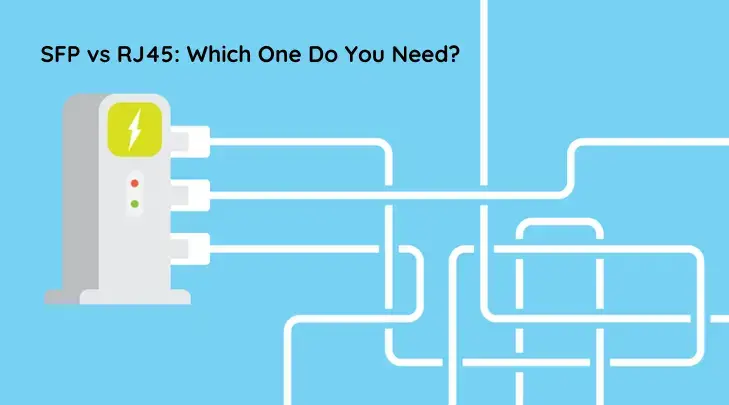SFP vs RJ45: A Clear Difference With Its Factors & Case Example

Affiliate Disclaimer
As an affiliate, we may earn a commission from qualifying purchases. We get commissions for purchases made through links on this website from Amazon and other third parties.
Table of Contents
RJ45 and SFP: Common Factors
The first principle is appropriate for any case of 1000Mbps deployment. When the distance of the run is over 328 ft/100 m, the fiber SFP module must be considered instead of the copper RJ45 port or copper SFP RJ45 module since 1000Mbps could only go as far as 100 meters over copper cabling.
When the link distance is less than 100 meters, there are some additional guidelines to consider when deciding whether to utilize RJ45 or SFP.
Security
In some extreme cases, a fiber SFP module is preferable rather than a Cat5e/6 RJ45 Ethernet cable or an SFP RJ45 module. Because RJ45 employs electric current, it is more likely to catch fire or light, whereas the fiber SFP module has no such issue.
In addition, employing a fiber optic module is safer in terms of Internet security because tapping copper cable to intercept data transmissions is more effortless than tapping fiber optic cable. When security is a concern in a connection, a fiber SFP port is preferable over an RJ45 port.
Reliability
Due to its quality properties, fiber SFP is considered a more reliable option.
Because copper RJ45 Ethernet cable uses an electric transmission, it is prone to interference. When an electric signal is influenced by external factors, such as a high voltage source, the problem is known as EMI (Electromagnetic Interference). Choose fiber SFP over copper RJ45 cabling when the cable route passes through areas where the electric signal may interfere.
Longevity
Fiber SPF optic cable is more future-proof than Cat7/Cat8 RJ45 Ethernet connection if you plan to upgrade to higher capacity, such as 10Gbps, in the near future.
Cost
The RJ45 Ethernet port and the SFP port runs at the same speed. Because Cat7/8 cable is less expensive than the SFP transceiver module, using RJ45 ports to link the switches is more cost-effective.
Latency
Latency is a technical name for how fast your data transmission work. It is measured in milliseconds (ms), and the lower the ms count, the better the connection and vice versa for higher latency.
SFP ports feature a reduced latency when connecting devices over a long distance than RJ45 ports, providing poor service. Hence if it’s the best connection you need, SFP is the way to go.
Power Consumption
It is common to believe that if SFP has so many advantages over RJ45, it must consume a tremendous amount of electricity, resulting in increased bills, but that’s not the case.
When compared to RJ45 connections, SFP ports consume less power. The difference in usage will be much more noticeable in an extensive network.
With so many options giving a positive weightage to SFP, let’s see a case that if it’s actually any good or not.
Real Case Example of 1000Mbps Connection
Case: 1
Two buildings with approximately 100 meters distance require a gigabit switches connection. Which one is the better option, RJ45 or SFP?
Analysis
RJ45 is cost-effective; however, it is necessary to consider other factors, including technical and non-technical, to decide which type of cable will be the best.
To begin with, if the two buildings have independent electrical power inputs, putting copper between them could result in ground loop concerns, so opt for fiber.
Second, when using copper cable over buildings, lightning strikes may be an issue, so again SPF becomes the vital choice.
If neither fiber nor copper cable is possible, RJ45 ports and SFP ports will not function correctly in this case. Hence, going wireless is the best option.
Case: 2
SFP ports are always utilized instead of RJ45 Ethernet ports when connecting devices in the same rack. Why employ SFP ports in this situation despite the high cost of this solution?Analysis
It involves putting 1000Mbps switches in the same rack. An SFP port is used instead of an RJ45 connector. Another explanation could be the amount of energy used. SFP ports are more energy-efficient than Ethernet ports when there are more than 100 links.
SFP vs RJ45: Which is Better? The Conclusion
There is no doubt that SFP cables are more reliable when transmitting data and less power-hungry. However, the manufacturing and retailing cost of SFP is higher than RJ45, making them less selective for an individual.
Both SFP and RJ45 have their own place of use. If you have an in-house data center with lots of links, then SFP is good. It is also reliable if you’re into the network and server business.
RJ45 is much more affordable and suitable for small offices and homes with a network modem to use the wired connection to your laptop, gaming consoles, PCs, and more related electronics.
Frequently Asked Questions
Q.1. Why do many people still use RJ45?
Ans. RJ45 is less expensive and fulfills the need for commercial use, such as an internet connection. It gets the job done at a lower price with penny maintenance. Also, the RJ45 port is widely available in electronics such as laptops, computers, TV, PCs, etc.Q.2. Is SFP port Ethernet?
Ans. An SFP port is a slot on a network device into which you can insert small SFP transceivers.Q.3. What is copper SFP?
Ans. Copper SFP is a transceiver module that is either SFP (small form-factor pluggable) or micro GBIC (gigabit interface converter). Copper SFP offers 1000Mbps over Cat5 cables with RJ45 connectors, allowing communications over Cat5 unshielded twisted-pair copper cable with link lengths of 100 meters.About the author

Written by
Robert Mills
My name is Robert Mills. If you want a high-speed internet or cable TV connection in your multiple devices like monitors, TVs, media players, consoles, etc. from a single coaxial signal, then you can get it done with the help of a coax splitter.
Comments (0)
No comments yet. Be the first to share your thoughts!